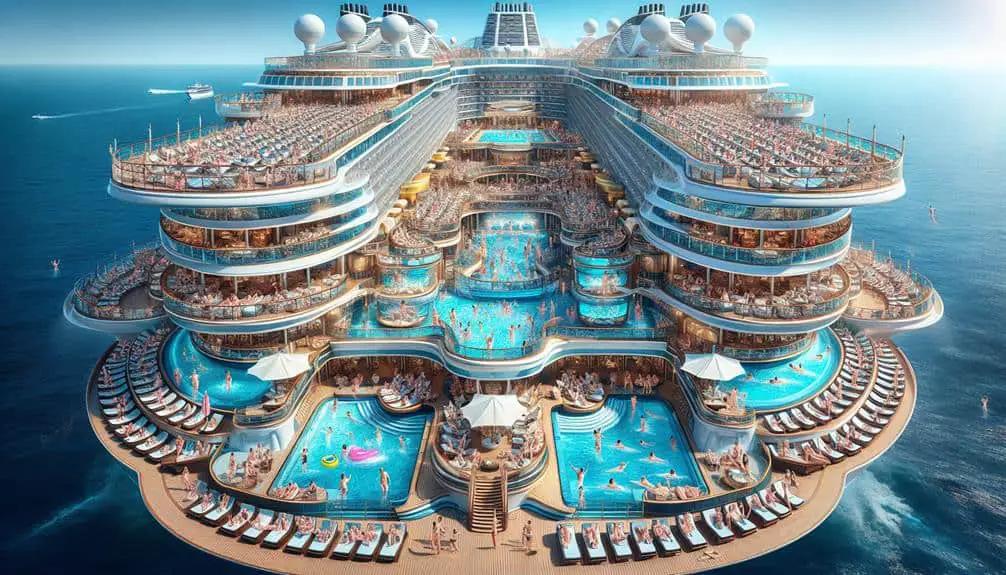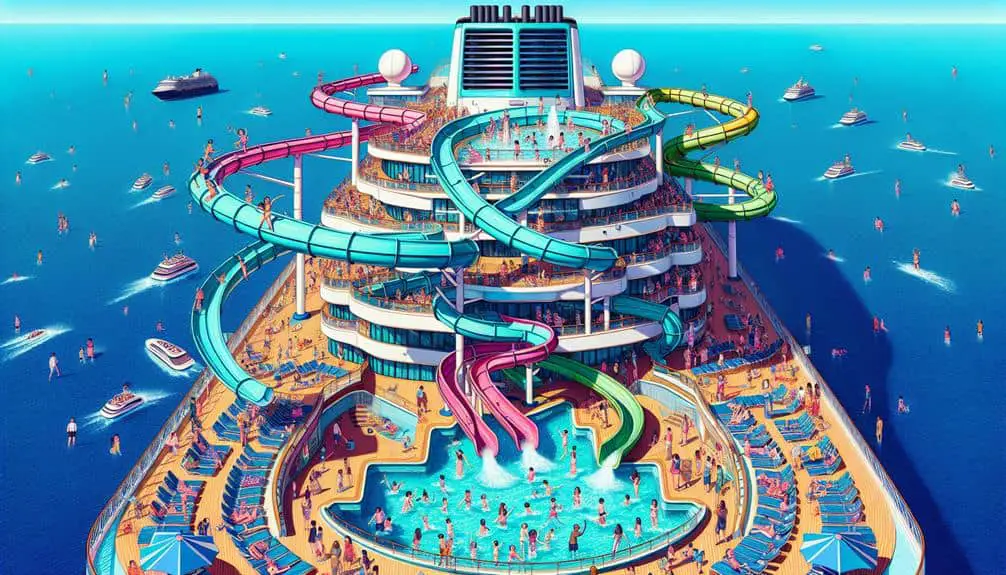Enhance your large cruise ship comfort by optimizing spatial layouts strategically, innovating cabin configurations, elevating public areas with cutting-edge designs, integrating advanced technologies for passenger comfort, and implementing eco-friendly initiatives. Discover the secrets to creating the ultimate cruising experience.
Key Points
- Strategically place high-traffic areas for convenience and efficiency.
- Design quiet zones away from noise for relaxation.
- Implement ergonomic seating in dining areas for comfort.
- Utilize technology for customizable environments and passenger comfort.
- Incorporate sustainability initiatives for a cleaner and eco-friendly cruising experience.
Spatial Layout Optimization
To enhance cruise ship design, consider optimizing the spatial layout to maximize efficiency and passenger comfort. Efficiency improvements can be achieved by strategically placing high-traffic areas near each other, reducing the time passengers spend walking between amenities. This optimization not only saves time but also enhances the overall flow of the ship.
Additionally, by carefully planning the spatial layout, customer experience enhancements can be realized. For example, creating designated quiet areas away from noisy recreational spaces can provide passengers with peaceful retreats. In addition, incorporating ergonomic seating arrangements in dining areas can improve comfort during meals.
Innovative spatial design can also lead to efficiency improvements in service delivery. Placing cabins in close proximity to elevators or staircases can streamline housekeeping operations and reduce staff fatigue. Moreover, optimizing the layout for passenger comfort can contribute to higher satisfaction levels and increased repeat business. By prioritizing efficiency and passenger comfort in spatial design, cruise ships can offer a superior experience that sets them apart in the industry.
Cabin Configuration Strategies
Consider implementing innovative cabin configuration strategies to optimize spatial layout and enhance passenger experience on cruise ships. When designing cabin layouts, focus on providing flexible configurations and ergonomic furnishing to guarantee maximum comfort and functionality for guests.
Here are four key strategies to enhance cabin configurations:
- Modular Furniture: Integrate modular furniture pieces that can be easily adjusted or reconfigured to accommodate different needs and preferences, optimizing space utilization.
- Multi-Functional Spaces: Design cabin areas that serve multiple purposes, such as combining sleeping and living areas, to make efficient use of the available space.
- Storage Solutions: Implement clever storage solutions that maximize space, such as built-in cabinets, under-bed storage, and wall-mounted organizers.
- Natural Light Integration: Utilize innovative design techniques to enhance natural light penetration in cabins, creating a bright and airy atmosphere that contributes to passenger well-being.
Public Area Design Enhancements
Implementing cutting-edge design principles can revolutionize public areas on cruise ships, elevating the overall passenger experience to new heights. When considering furniture placement, it's important to create versatile spaces that can accommodate different activities throughout the day. Modular furniture arrangements can allow for flexible use of space, catering to various passenger needs. Additionally, incorporating ergonomic seating options guarantees comfort and promotes relaxation in these shared areas.
Lighting design plays a significant role in enhancing the ambiance of public spaces on cruise ships. Strategic placement of lighting fixtures can create different moods, from vibrant and energetic to calm and intimate. Utilizing a combination of natural and artificial lighting sources can help achieve the desired atmosphere while also being energy-efficient. Dimmable lights provide the flexibility to adjust brightness levels based on the time of day or specific events, enhancing the overall aesthetic appeal and functionality of the public areas.
Technology Integration for Comfort
Integrating state-of-the-art technology seamlessly into cruise ship design enhances passenger comfort and elevates the onboard experience to unprecedented levels. When it comes to technology integration for comfort, cruise ships are constantly evolving to provide passengers with the ultimate luxury experience.
- Smart Automation Systems: These systems control everything from lighting and temperature to entertainment options in passenger cabins, allowing guests to customize their environment with ease.
- Interactive Touchscreen Panels: Interactive panels are being integrated into cabin walls, enabling passengers to manage room settings, access information, and even book onboard activities at their fingertips.
- Ergonomic Furniture Design: Cruise ships are incorporating ergonomic furniture designs in cabins and public areas to ensure maximum comfort and support for passengers during their voyage.
- Virtual Reality Entertainment: Some cruise lines are introducing virtual reality lounges where passengers can immerse themselves in interactive experiences, enhancing onboard entertainment options.
Sustainability Innovations for Cruisers
Sustainable cruising demands a strategic approach to integrating eco-friendly practices and innovations into ship operations. Eco-friendly initiatives are essential for reducing the environmental impact of cruise ships.
Implementing energy-efficient solutions like LED lighting, advanced propulsion systems, and smart HVAC systems can greatly decrease fuel consumption and emissions. Utilizing solar panels and wind turbines can harness renewable energy sources to power onboard operations, further reducing reliance on traditional fuels.
Waste management systems that recycle and treat wastewater onboard contribute to a cleaner marine environment. Additionally, optimizing hull design for improved hydrodynamics can enhance fuel efficiency and reduce drag, leading to lower carbon emissions.
Frequently Asked Questions
What Are Some Common Challenges Faced in Designing for Larger Cruise Ship Comfort That May Not Be Addressed in the Article Sections?
When designing for larger cruise ship comfort, common challenges may include optimizing cabin layout for efficiency and reducing noise levels to enhance passenger experience. These factors are essential for creating a relaxing onboard environment.
How Do Factors Such as Weather Conditions and Sea Turbulence Impact the Design Considerations for Larger Cruise Ship Comfort?
Consider weather conditions when planning architectural layout for larger cruise ship comfort. Sea turbulence impacts design choices such as stabilizers and materials. Address these factors to optimize passenger experience and safety in all conditions.
Are There Any Specific Cultural or Regional Preferences That Are Taken Into Account When Designing for Larger Cruise Ship Comfort?
Consider cultural preferences and regional influences when designing for larger cruise ship comfort. These factors impact layout, amenities, and decor choices. Tailoring design to specific tastes guarantees a more satisfying experience for passengers from diverse backgrounds.
How Do Advancements in Materials and Construction Techniques Play a Role in Enhancing Comfort on Larger Cruise Ships?
Innovations in materials and construction techniques revolutionize comfort on larger cruise ships. Materials innovation enhances durability and aesthetics, while advanced construction methods optimize spatial design. Seamlessly integrating these advancements elevates the overall passenger experience to new heights of luxury and functionality.
What Considerations Are Made for Passengers With Accessibility Needs in the Design of Larger Cruise Ships?
Consider accessible amenities like ramps, wider doorways, and elevators. Implement universal design principles for all areas. Guarantee cabins, public spaces, and facilities cater to various needs. Prioritize inclusivity and ease of movement for all passengers.




